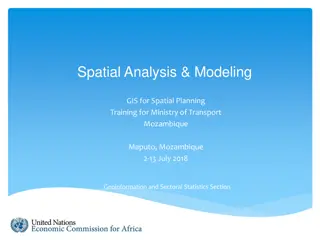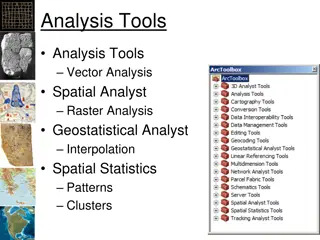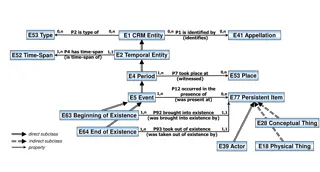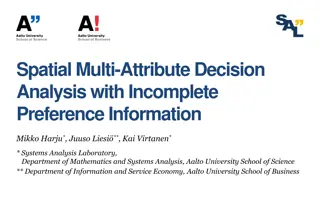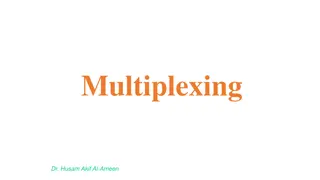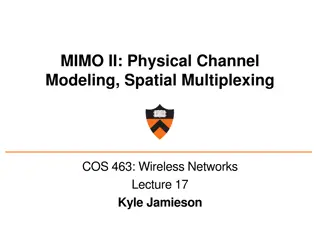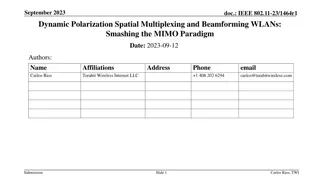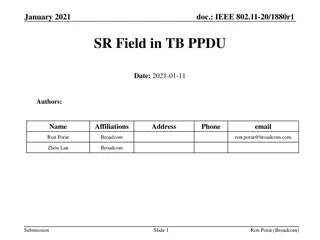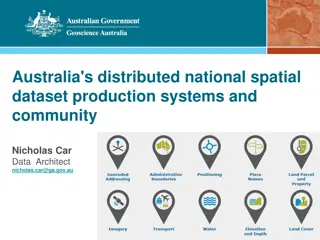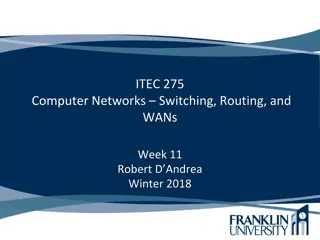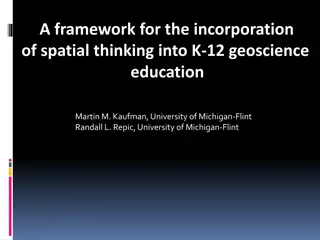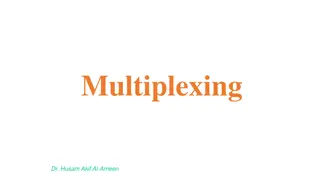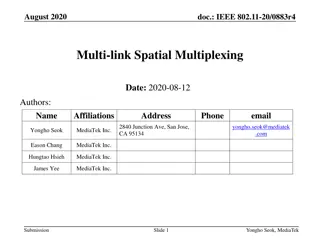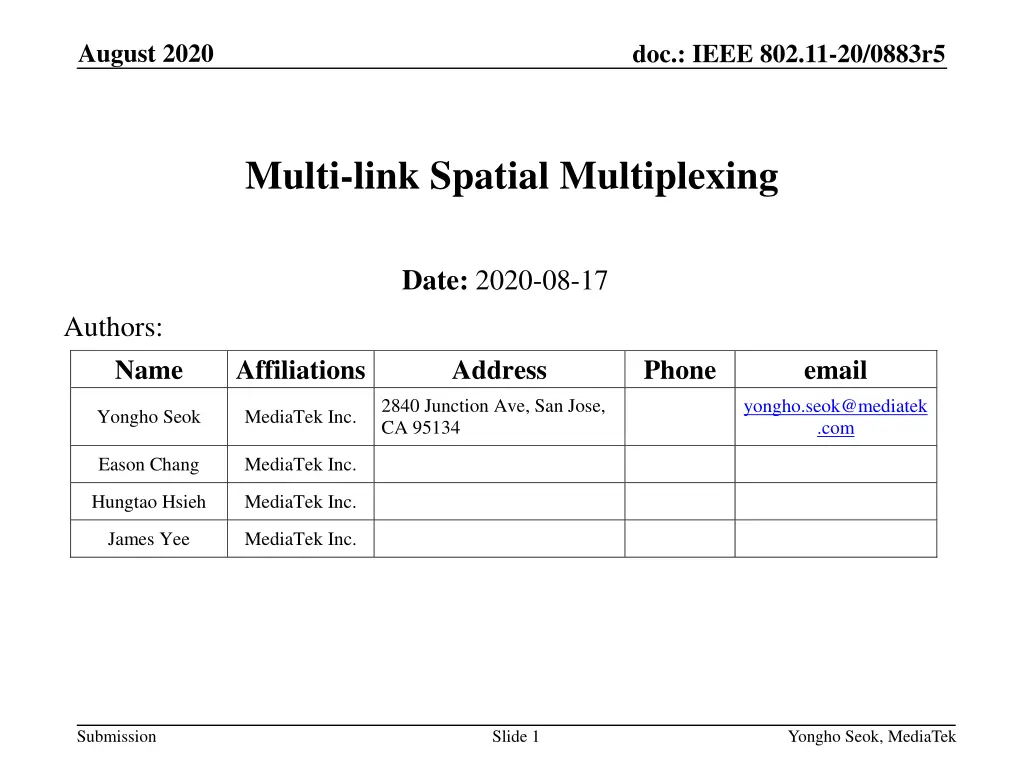
IEEE 802.11-20/0883r5 Multi-link Spatial Multiplexing
In this document dated August 2020, Yongho Seok from MediaTek discusses the spatial multiplexing capabilities of an STA MLD, focusing on receive chains switching between links. The enhanced single-radio MLD allows for dynamic reconfiguration of spatial multiplexing capabilities, ensuring efficient utilization of receive and transmit chains across links. The potential for performance enhancements in multi-radio non-AP MLDs is explored through examples of chain switching scenarios in response to frame exchanges.
Download Presentation

Please find below an Image/Link to download the presentation.
The content on the website is provided AS IS for your information and personal use only. It may not be sold, licensed, or shared on other websites without obtaining consent from the author. If you encounter any issues during the download, it is possible that the publisher has removed the file from their server.
You are allowed to download the files provided on this website for personal or commercial use, subject to the condition that they are used lawfully. All files are the property of their respective owners.
The content on the website is provided AS IS for your information and personal use only. It may not be sold, licensed, or shared on other websites without obtaining consent from the author.
E N D
Presentation Transcript
August 2020 doc.: IEEE 802.11-20/0883r5 Multi-link Spatial Multiplexing Date: 2020-08-17 Authors: Name Affiliations Address Phone email 2840 Junction Ave, San Jose, CA 95134 yongho.seok@mediatek .com Yongho Seok MediaTek Inc. Eason Chang MediaTek Inc. Hungtao Hsieh MediaTek Inc. James Yee MediaTek Inc. Submission Slide 1 Yongho Seok, MediaTek
August 2020 doc.: IEEE 802.11-20/0883r5 Recap: Enhanced single-radio MLD In an enhanced single-radio MLD [1], a single-radio MLD can switch the transmit and receive chains across links. An MLD that can: 1) transmit or receive data/management frames to another MLD on one link, and 2) listening on one or more links. The listening operation includes CCA as well as receiving initial control messages (e.g., RTS/MU-RTS) Link switch delay may be indicated by the non-AP MLD The transmit and receive chains switching across links can be also applied to a multi-radio non-AP MLD for a performance enhancement. Submission Slide 2 Yongho Seok, MediaTek
August 2020 doc.: IEEE 802.11-20/0883r5 Motivation A STA MLD supports the following spatial multiplexing capability for each link. R1 receive chains and T1 transmit chains on the link1. R2 receive chains and T2 transmit chains on the link2. If the STA MLD can dynamically reconfigure its spatial multiplexing capability on each link, a STA MLD can support (R1+R2) receive chains and (T1+T2) transmit chains on the link1 and the link2 respectively. But, total receive chains and transmit chains that can be used at a time shall not be greater than (R1+R2) and (T1+T2) respectively. Submission Slide 3 Yongho Seok, MediaTek
August 2020 doc.: IEEE 802.11-20/0883r5 Multi-link Spatial Multiplexing: Receive Chains Switching If a STA in a STA MLD receives a RTS/MU-RTS frame from an AP in an AP MLD and it responds with a CTS frame, other STAs in the STA MLD switch their receive (and transmit) chains to the link on which the STA exchanged the RTS/MU-RTS and CTS frames. The RTS/MU-RTS frame starts a frame exchange sequence. The RTS/MU-RTS frame is transmitted with a single-spatial stream. The AP in the AP MLD can transmit to the STA in STA MLD a PPDU up to the total supported Rx spatial streams (e.g., R1+R2) of the STA MLD. Submission Slide 4 Yongho Seok, MediaTek
August 2020 doc.: IEEE 802.11-20/0883r5 Multi-link Spatial Multiplexing: Receive Chains Switching Receive chains switching example After a STA1 in a STA MLD receives a RTS frame addressed to itself, while it transmits a CTS frame, the STA2 in the same STA MLD switches all receive chains on the link2 to the link1. An AP1 in an AP MLD can transmit a PPDU up to the total supported Rx spatial streams of the STA MLD, instead of the supported Rx spatial streams of each link. At the end of the TXOP, the STA1 switches at least one of the receive chains from the link1 to the link2. Submission Slide 5 Yongho Seok, MediaTek
August 2020 doc.: IEEE 802.11-20/0883r5 Multi-link Spatial Multiplexing: Transmit Chains Switching If a STA in a STA MLD transmits a RTS frame and it receives a CTS frame, other STAs in the STA MLD switch their transmit (and receive) chains to the link on which the STA is operating. The RTS frame starts a frame exchange sequence. The STA in the STA MLD can transmit a PPDU up to the total supported Tx spatial streams (e.g., T1+T2) of the STA MLD. Submission Slide 6 Yongho Seok, MediaTek
August 2020 doc.: IEEE 802.11-20/0883r5 Multi-link Spatial Multiplexing: Transmit Chains Switching Transmit chains switching example After a STA1 in a STA MLD receives a PHY-RXSTART.indication primitive of a CTS frame sent in a response to a RTS frame, while it receives the CTS frame, a STA2 in the same STA MLD switches all transmit chains on the link2 to the link1. The STA1 can transmit a PPDU up to the total supported Tx spatial streams of the STA MLD, instead of the supported Tx spatial streams of each link. At the end of the TXOP, the STA1 switches at least one of the transmit chains from the link1 to the link2. Submission Slide 7 Yongho Seok, MediaTek
August 2020 doc.: IEEE 802.11-20/0883r5 Capability Signaling for Multi-link Spatial Multiplexing A non-AP MLD indicates the following capabilities. Maximum number of spatial streams supported for each link. Total number of spatial streams that the non-AP MLD can receive at a time among a specified set of links. Submission Slide 8 Yongho Seok, MediaTek
August 2020 doc.: IEEE 802.11-20/0883r5 Capability Signaling for Multi-link Spatial Multiplexing Example 0: Enhanced single-radio MLD Maximum number of spatial streams supported for each link. 2 SSs on the link 1; 2 SSs on the link 2. Total number of spatial streams that the non-AP MLD can receive at a time among a specified set of links. 2 SSs. Single-radio operation of the non-AP MLD Case 1 2 SSs on the link 1; 0 SSs on the link 2. Case 2 0 SSs on the link 1; 2 SSs on the link 2. Submission Slide 9 Yongho Seok, MediaTek
August 2020 doc.: IEEE 802.11-20/0883r5 Capability Signaling for Multi-link Spatial Multiplexing Example 1: Enhanced multi-radio MLD Maximum number of spatial streams supported for each link. 2 SSs on the link 1; 2 SSs on the link 2. Total number of spatial streams that the non-AP MLD can receive at a time among a specified set of links. 2 SSs. Default multi-radio operation of the non-AP MLD 1 SSs on the link 1; 1 SSs on the link 2. Single-radio operation of the non-AP MLD Case 1 2 SSs on the link 1; 0 SSs on the link 2. Case 2 0 SSs on the link 1; 2 SSs on the link 2. Submission Slide 10 Yongho Seok, MediaTek
August 2020 doc.: IEEE 802.11-20/0883r5 Capability Signaling for Multi-link Spatial Multiplexing Dynamic change between a default multi-radio operation and a single-radio operation can be supported by the receive operating mode indication mechanism. The OM Control subfield is needed to be extended to the multi- link. In the example 1, When changed to a default multi-radio operation, the OM Control subfield signals the following: 1 SSs on the link 1; 1 SSs on the link 2. When changed to a single-radio operation, the OM Control subfield signals the following: 2 SSs on the link 1; 2 SSs on the link 2. Additional indication for the single-radio operation is TBD. Submission Slide 11 Yongho Seok, MediaTek
August 2020 doc.: IEEE 802.11-20/0883r5 Conclusion This contribution generalizes the transmit and receive chains switching concept of the enhanced single-radio non-AP MLD for the multi-radio non-AP MLD. Through the transmit and receive chains switching on multiple links, the multi-radio non-AP MLD also can expect the further throughput performance enhancement. Submission Slide 12 Yongho Seok, MediaTek
August 2020 doc.: IEEE 802.11-20/0883r5 References [1] https://mentor.ieee.org/802.11/dcn/20/11-20-0562-03-00be- enhanced-multi-link-single-radio-operation.pptx Submission Slide 13 Yongho Seok, MediaTek
August 2020 doc.: IEEE 802.11-20/0883r5 Straw Poll 1 Do you support the TGbe spec shall define a mechanism that in R1 a non-AP MLD indicates maximum number of spatial streams that it is capable of transmitting or receiving at a time, while operating in any of the links within the specified set of links in which the enhanced multi-link operation mode is applied? Each STA in the non-AP MLD operating in any of the links within the specified set of links shall support the indicated maximum number of spatial streams. The enhanced multi-link operation mode is optional. Note- The name of the enhanced multi-link operation mode can be changed. Submission Slide 14 Yongho Seok, MediaTek


